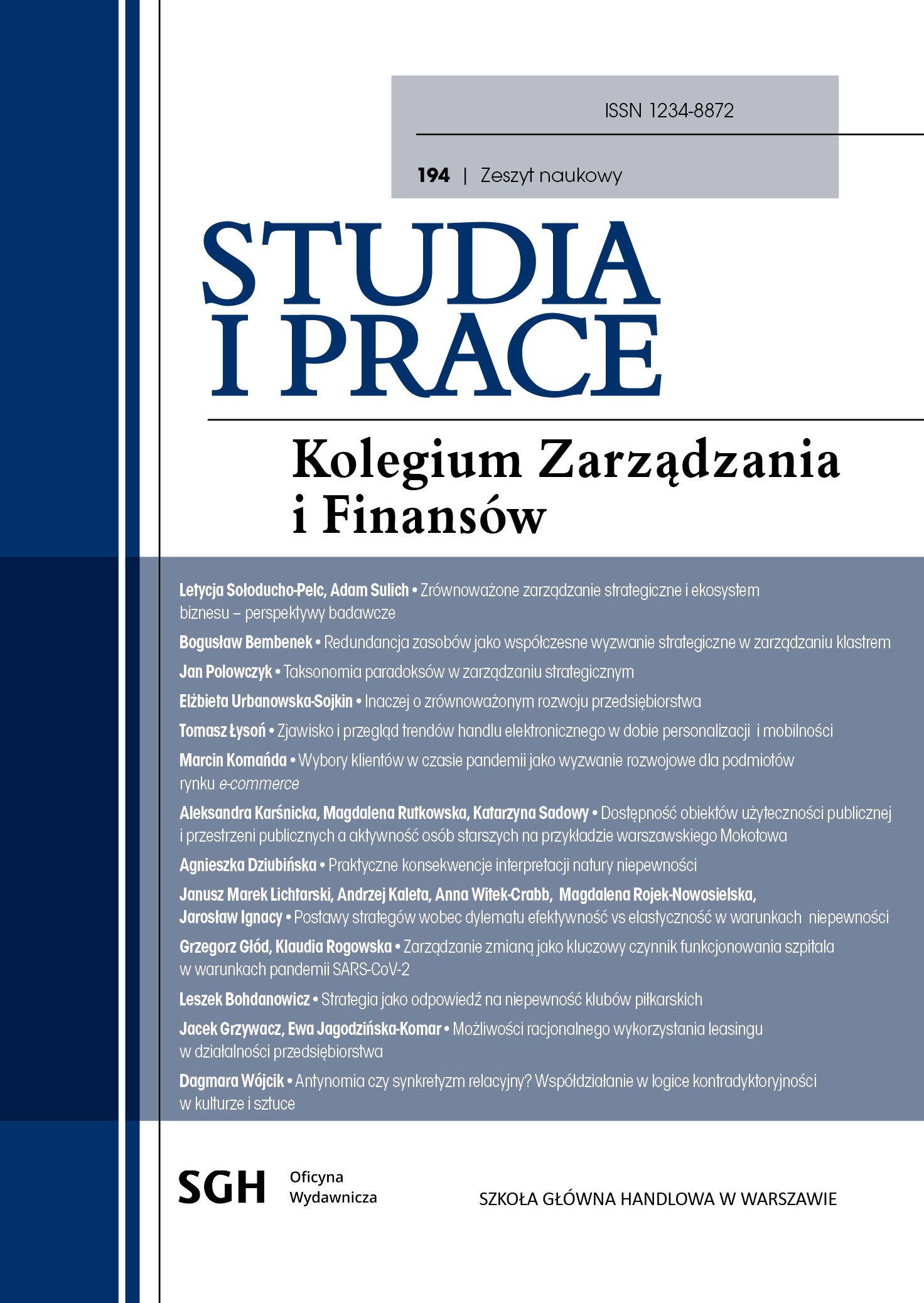On sustainable business development in other words
DOI:
https://doi.org/10.33119/SIP.2023.194.4Keywords:
mandates for management, organizational strategic capabilities, sustainable developmentAbstract
Sustainable development of organizations is a term that is often used as a label for a company’s response and orientation to social demand, as well as recommendations stemming from international resolutions. In the content of works addressing sustainable business development, there is a lack of indication of specific methods and directions of development, as well as ways to measure and assess its level. The aim of the study is to consider sustainable business development as the outcome of utilizing organizational
capabilities that induce mandates for management 4.0 and 5.0 and strategic efficiency. The mandates for management include: agility, resilience, and vitality understood as dynamism and operability. The content of the paper aligns with considerations on the resource-oriented approach to strategic management and develops the thoughts on the exposition areas in the organization in terms of sustaining different aspects of organizational development as well as assessing its outcomes, utilizing various types of strategic efficiency.
Downloads
References
Dokumenty prawne
ONZ (2015). Agenda Zrównoważonego Rozwoju 2030, rezolucja przyjęta przez Zgromadzenie Ogólne w dniu 25 września 2015 r. (A/RES/70/1).
Wydawnictwa zwarte
Beck, U., Giddens, A., Lash, S. (red.). (1996). Reflexive Modernisierung. Eine Kontroverse. Frankfurt/Main: Suhrkamp.
Beck, U., Giddens, A., Lash, S. (red.). (1996). Reflexive Modernization: Politics, Tradition and Aesthetics in the Modern Social Order. Cambridge: Polity Press.
Bennis, W., Nanus, B. (1986). Leaders: Strategies for Taking Charge. New York: Harper & Row.
Borys, T., Fiedor, B. (2014). Operacjonalizacja i pomiar kategorii zrównoważonego rozwoju –przyczynek do dyskusji. W: Rachunki narodowe. Wybrane problemy i przykłady zastosowania (s. 53–68), M. Plich (red.). Warszawa: GUD, Uniwersytet Łódzki.
Buchler, R. P. (2022). Die neue Leadership DNA. Prinzipien fur einen radikalen Umbau der Fuhrung. Hoboken: Wiley-VCH GmbH.
Gaulner, F., Villhauer, B. (2021). Alles neu. Geschaftsidee, Geschaftsmodell. Unternehmensplanung. Kiel: UVK Verlag.
Giddens, A. (2001). Nowoczesność i tożsamość. „Ja” i społeczeństwo w epoce późnej nowoczesności. Warszawa: Wydawnictwo Naukowe PWN.
Giddens, A. (2003). Stanowienie społeczeństwa. Zarys teorii strukturacji. Poznań: Zysk i S-ka.
Hulsmann, M., Wójcik, K. (2006). Selbstorganisation als Ansatz zur Flexibilisierung der Kompetenzstrukture. W: Neue Perspektiven des Strategischen Kompetenz-Managements (s. 323–350), Ch. Burmann, M. Hulsmann, J. Freiling (Hrsg.). Wiesbaden: Springer Verlag.
Muller, B. (2018). Vitalitat fur Unternehemen. Mit Corporate Higiene zur mehr produktivitat und Gewinn. Norderstedt: Books on Demand.
Palzkill, A. (2017). Geschaftsmodel – Resilienz. Wiesbaden: Springer Verlag.
Ruhl, U. (2020). Unternehmerische Resilienz, So werden Organisationen agil und widerstandsfähig. New Jersey: John Wiley & Sons.
Schwuchow, K., Gutmann, J. (2020). HR-Trends 2020: Agilitat, Arbeit 4.0, Analytics, Prozesse. Fryburg: Haufe-Lexware.
Shore, J. (2023). Die Kunst der agilen Entwicklung. Grundlagen, Methoden, Praktiken. Heidelberg: dpunkt Verlag.
Trzcieliński, S. (red.). (2007). Agile Enterprise. Concepts and Some Results of Research. Madison: IEA, University of Wisconsin.
Trzcieliński, S. (2011). Przedsiębiorstwo zwinne. Poznań: Wydawnictwo Politechniki Poznańskiej.
Unkrig, E. (2018). Das resiliente Unternehmen: Learned Not Given. Mit dem ECHO_KONZEPT und der Umsetzung mit Resibility. Norderstedt: Books on Demand.
Unkrig, E. (2020). Mandate der Führung 4.0: Agilität – Resilienz – Vitalität. Wiesbaden: Springer Verlag.
Urbanowska-Sojkin, E. (2021). Sprawność przedsiębiorstw w warunkach niepewności. Teoria i praktyka. Warszawa: PWE.
Urbanowska-Sojkin, E., Weinert, A. (2020). Otwarte formułowanie strategii z wykorzystaniem kolektywnej inteligencji przedsiębiorstwa. W: Zarządzanie strategiczne w dobie cyfrowej gospodarki sieciowej (s. 19–36), S. Gregorczyk, G. Urbanek (red.). Łódź: WUŁ. DOI:10.18778/8220-335-6.02.
Artykuły naukowe
Carpenter, S., Walter, B., Anderies, J., Abel, N. (2001). From Metaphor to Measurement. Resilience What to What, Ecosytem, 4 (8). DOI: 10.1007/s10021-001-0045-9.
Fuster Morell, M., Espelt, R., Renau Cano, M. (2020). Sustainable Platform Economy: Connections with the Sustainable Development Goals, Sustainability, 12 (18), s. 7640. DOI: 10.3390/su12187640.
Heller, J., Gallenmüller, N. (2017). Resilienzberatung für die VUKA-Welt, SEM Radar, 16 (1).
Horne, P. J., Lowe, C. F. (1997). Toward a Theory of Werbal Behawior, Journal of the Experimental Analysis of Behavior, 68 (2), s. 271–196. DOI: 10.1901/jeab.1997.
Mallak, L. (1998). Puting Organizational Resilience to Work, Industrial Management, 40.
Masten, A. S., Best, K., Garmezy, N. (1990). Resilience and Development: Contributions from the Study of Children Who Overcome Adversity, Development and Psychopathology,
, s. 425–444.
Ofoegbu, O. E., Akanbi, P. A. (2012). The Influence of Strategic Agility on the Perceived Performance of Manufacturing Firms in Nigeria, International Business and Economics Research Journal, 11 (2), s. 153. DOI: 10.19030/iber.v11i2.6769.
Sanchez, M., Nagi, R. (2001). A Review of Agile Manufacturing Systems, International Journal of Production Research, 39 (16), s. 3561–3600. DOI: 10.1080/00207540110068790.
Schumacher, T., Wimmer, R. (2019). Der Trend zur hierarchiearmen Organisation Zur Selbstorganisationsdebatte in einem radikal veränderten Umfeld, Organisations Entwicklung, 2, s. 13–17.
Skrzypczyński, R. (2020). Postwzrost, dewzrost, awzrost – polska terminologia dla różnych wariantów, Czas Kultury, 3, s. 7–13.
Teece, D. J. (2012). Dynamic Capabilities: Routines versus Entrepreneurial Action, Journal of Management Studies, 49 (8), s. 1395–1401.
Teece, D. J., Pisano, G., Shuen, A. (2017). Dynamic Capabilities and Strategic Management, Strategic Management Journal, 18 (7), s. 509–533.
Urbanowska-Sojkin, E. (2018a). Informacyjne fundamenty kreatywności w kontekście zarządzania strategicznego, Przegląd Organizacji, 3, s. 35–39. DOI: 0.33141/po.2018.03.06.
Urbanowska-Sojkin, E. (2018b). Uwarunkowania kreatywności w przedsiębiorstwach w perspektywie strategicznej, Organizacja i Kierowanie, 181 (2), s. 135–146.
Urbanowska-Sojkin, E. (2022). Kolonizacja ryzyka wdrażania strategii w przedsiębiorstwach, Organizacja i Kierowanie, 2 (191), s. 67–81.
Materiały internetowe
Stankiewicz, P. (2013). Niewidzialne ryzyko. O społecznej konstrukcji bezpieczeństwa, https://repozytorium.umk.pl/bitstream/handle/item/1021/P.%20Stankiewicz%2C%20Niewidzialne%20ryzyko.pdf?sequence=1 (dostęp: 3.02.2023).
Downloads
Published
How to Cite
Issue
Section
License
Copyright (c) 2024 Studies and Work of the Collegium of Management and Finance

This work is licensed under a Creative Commons Attribution 4.0 International License.









